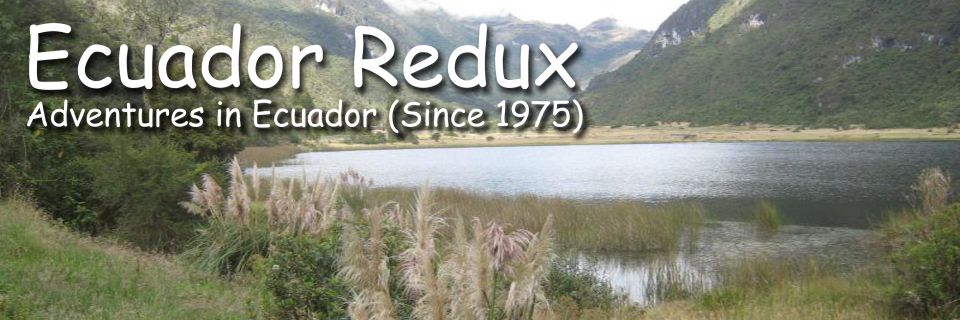Holiday Celebrations in Cuenca: El Pase del Niño, El Año Viejo, & La Fiesta de los Inocentes
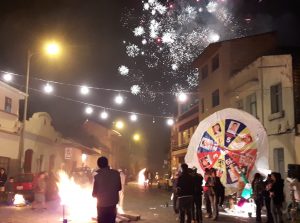
Holiday Celebrations: New Year’s Eve in Barrio El Vado: Fireworks and Burning Effigies
Holiday Celebrations in Cuenca: El Pase del Niño, El Año Viejo, & la Fiesta de los Inocentes
If you’ll give me a moment I’ll share our observations about holiday celebrations in Cuenca. It’s fascinating and, oh, so different than North America. Think Mardi Gras in New Orleans, but rated PG. During the Christmas season in Cuenca there are 3 major holiday celebrations, plus Christmas, each with a different history:
- El Pase del Niño
- El Fin del Año
- La Fiesta de los Santos Inocentes.
Let me start with our story.
We recently returned from 38 days in the US, which explains the lack of blog posts in December. We enjoyed wonderful visits with family and friends, from North Carolina to Chicago. We ate turkey and cranberries, exchanged presents on Christmas day, and filled our suitcases for the return trip. The frigid Chicago weather reminded us of why we had left for Ecuador – no more driving with snow and fogged up windows, after dark, in rush hour on the Eisenhower Expressway. No más!
While spending quality time with family was wonderful, returning home to Ecuador called for some re-adjustments and reflections, perhaps a touch of culture shock. For me, it felt as if my feet weren’t firmly planted on the ground for a couple days — first in Guayaquil, where we landed, and then in Cuenca. I spent the bus ride back to Cuenca reading a book and ignoring surroundings. Once in Cuenca, we returned to our “holding pattern” waiting for resident visa documents to be approved and to our old routines: reading, talking, and thinking in Spanish again, trying NOT to throw toilet paper in the toilet, walking to the market and back with bags of fruit and vegetables, riding the bus and walking everywhere, carrying an umbrella and a vest for changing weather, and having memories of our trip still floating in my head while striking up conversations with friendly Cuencanos in public spaces. We happily returned to our new Cuenca home, but the first few days I felt un-moored. It can happen to the best of us, I’m learning.. Now, on to the holiday festivities……
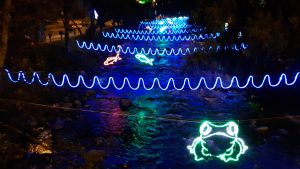
Holiday Celebrations: Decorations at the River Tomebamba
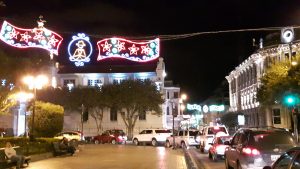
Holiday Celebrations: Main Plaza
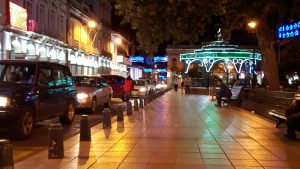
Holiday Celebrations: Main Plaza
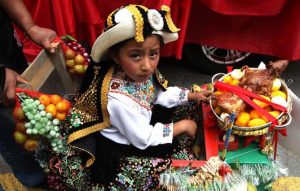
El Pase del Niño – photo by others
El Pase del Niño
Although it was sad to miss Cuenca’s Christmas Eve celebration this year, it must be mentioned. It is the biggest religious procession of the year and is viewed by as many as 100,000: el Pase del Niño Viajero (The Passing of the Traveling Child), or simply El Pase del Niño (The Passing of the Child). “The Child” referred to is baby Jesus. This is a day long parade that people prepare for months in advance. It includes rural indigenous and mestizo people from surrounding areas and urbanites as far away as Loja. Spectators include people from all over Ecuador and, of course, foreign tourists. It is the antithesis of the corporate Macy’s Day Parade, notes one blogger. Two writers note the mixture of sacred and profane – yes! Several expat blogs have written and photographed this Christmas Eve parade, featuring lavishly adorned children riding lavishly adorned horses! Read about it here , here, here, here and here.

El Pase del Niño – photo by others
“The eight-hour-plus procession features floats and decorated cars, many festooned with flowers, fruits and vegetables, empty beer cans and liquor bottles, roasted pigs and chickens. There are also bands, dancers and street performers, stilt-walkers and various Biblical characters. In recent years, the Three Wise Men have made an appearance on Harley Davidsons and Mary and Joseph have cart-wheeled the length of Calle Simon Bolivar. Everywhere there are children dressed in elaborate homemade costumes.”
“Introduced to Latin America by the Spanish almost 500 years ago, the Pase del Niño is a Christmas celebration in which likenesses of the infant Jesus are carried through towns and villages. In Ecuador, the tradition remains strongest in the Andean region. Organizers of the Cuenca parade claim that it is the largest Pase del Niño in all of Latin America…. ” (Miami Herald 28 Dec 2011)
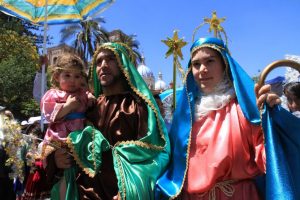
El Pase del Niño – photo by others
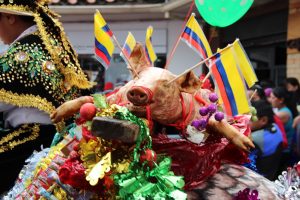
El Pase del Niño – photo by others

Life-like “old man” at downtown cafe
El Año Viejo: Public Expression in Public Space
While the US celebrates the “New Year,” Ecuador bids farewell to the “Old Year!” In Ecuador, the focus is people and events of the old year, el año viejo.. Rather than relying on the news media to publish “a year in review,” here citizens take to the streets to share their thoughts about the year. They do this with masks and art work that poke fun at anyone and anything. Political satire is their strongest suit!
Our first full day in Cuenca was New Year’s Eve, which we spent walking to the local market, the supermarket, and to downtown on errands. Everywhere we walked, we saw people selling masks and straw or papier-maché effigies (monigotes). Some were full-sized and others quarter sized. Most were of old men, but the custom has changed with the times. We saw a plane, a robot, a couple playing cards, Spiderman, and Sponge Bob. Masks included local and national politicians – the mayor, the president, and vice president were popular. Creativity, playfulness, and artful flare were in evidence in numerous displays (see photos).

Two effigies outside the local general store. Rough translation:” Hey, hey boys what is happening…. Shoot! I can’t work with you like this…..Today I want to see the balls. Good my son, it’s 4 o’clock in the afternoon and I’m going to volleyball. Shoot! Shoot!” (I can image the friend or acquaintance they are parodying.)

Mayor Cabrera mask/effigy in front of Bicycle Shop “A bicycle is not how someone gets to work”– Cabrera said in 2016
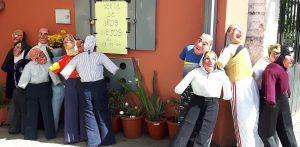
Sale of Effigies — “Old Years”
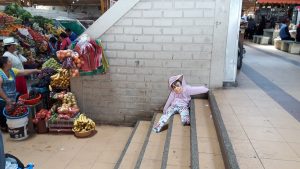
El Viejo looking lonely at el Mercado 27 de Febrero

John and El Viejo
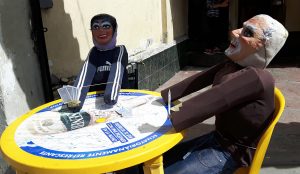
Man and Woman Effigies (perhaps political figures??) Playing Cards
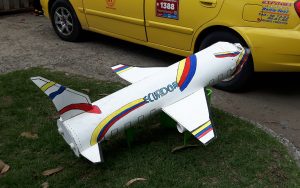
Ecuadorian Jet Airplane Effigy: Tame Airline had a very bad year!

Sponge Bob Effigy

Effigies of 5 of the 8 presidential candidates. A large plastic banner was draped behind saying “The Family Presents The Apocalyptics“
It was refreshing to see public displays of art and political expression. There is no grand political divide here, as in US. There is, instead, a culture of public political expression that is expected during everyday conversation (!!) and certainly fiestas, including Carnaval (our Mardi Gras) and the Old Year. Very refreshing!
Not knowing where the night-time festivities would be best, we walked through our Tres Puentes neighborhood only to find families setting off fire crackers and burning a few viejos in the street. I wanted more than that. I wanted to see piles of burning viejos! So off we walked down Avenida Solano at 10:30 at night. The avenue was well lit and cars were driving by and honking – some with viejos on their car hoods or bumpers. Revelry was in the air. A group of young men, all dressed as women was walking towards the bridge at Tres Puentes. One man walked towards us to flirt and we smiled, not knowing then that he was playing the viuda (widow) of the viejo. We didn’t know that an appropriate response would have been to give him/her some coins. (Note: el viejo refers to the old man in the form of an effigy who represents the old year.)
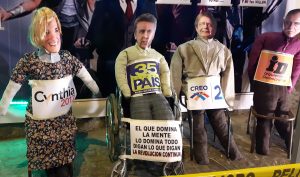
Barrio El Vado: Effigies of Presidential Candidates
Once downtown we discovered the main square to be devoid of action and asked a lady selling candies where the festivities were. She directed us to San Francisco Plaza, but we ended up following the crowds to “El Vado” — a neighborhood that dates to Colonial times. Barrio El Vado has talented artists! We witnessed a block-long gallery of papier mache animals and politicians each placed in a scene or mini-drama evocative of the events of 2016.. (Cruz El Vado is find-able on Google Maps, and was an early marker of Colonial city limits.)
As you can see from photos that follow, art and satire mix to create interesting commentaries on the state of affairs in Ecuador. As outsiders to most of the local and national politics, we were not able to understand much of the commentary – at least not this year. We learned later, from Cuenca High Life, that there are competitions between barrios for their displays. We missed seeing the winning display in Barrio El Vergel that was called “Trumplandia.” Chuta! Shoot!
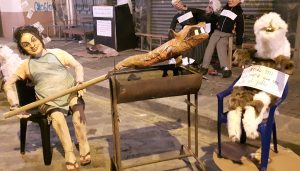
Barrio El Vado: Art and Satire: Woman roasting a guinea pig. Live Guinea Pig says “Waiting my turn to be put on the stick.”
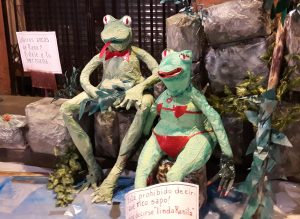
Barrio El Vado – Art Display Celebrating the Old Year. Female Frog: “It is not allowed to say ‘what a delicious toad!’ You should say ‘Beautiful Frog.'”
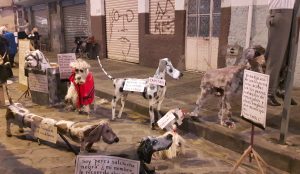
Barrio El Vado: Art and Political Satire. Loja’s mayor proposed “disappearing” all stray dogs.

Barrio El Vado: Art and Political Satire “I am also a police dog except I am dressed as an infiltrating indigenous person” and “Tell me when the Loja mayor is gone please. Adopt me before mankind kills me.”

Barrio El Vado: Art and Political Satire. Loja’s mayor Bolivar Castillo.
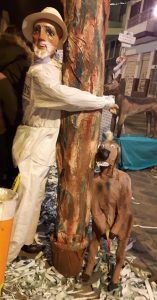
Barrio El Vado – Art Display Celebrating the Old Year. Dog says “Please plant more trees so that Mr Freddy can hug them and we can urinate on them”
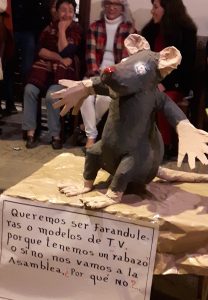
Barrio El Vado: Art and Satire: “We want to be TV stars or models because we have big tails, or if not, we will go to the National Assembly. Why not?

Barrio El Vado: Art and Political Satire: “Perro Tranvia” — “Light Rail Dog of Cuenca”
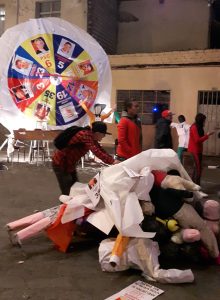
Barrio El Vado: Right Before Midnight — Preparing to Burn Effigies of the 8 Presidential Candidates
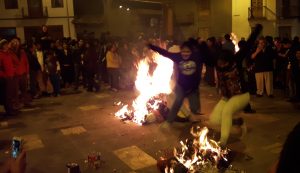
Barrio El Vado: Jumping Over Burning Effigies for Good Luck

Barrio El Vado at Midnight: Fireworks and Burning Effigies
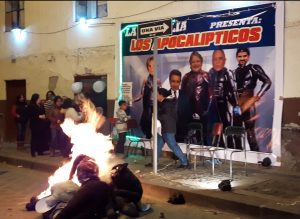
Barrio El Vado at Midnight: Fireworks and Burning Effigies
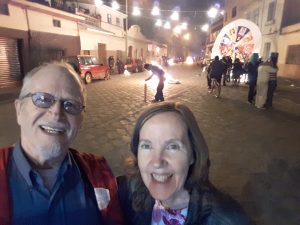
Selfie. “Old Year” 2016 Celebration in Barrio El Vado
As comparison to the Cuenca Old Year displays, living in Llullundongo in 1982 I witnessed a rural version of Old Year celebrations. A few straw men, los viejos, were dressed up and placed on benches of front porches or propped up beside houses. I do not remember the effigies wearing masks or being used as political satire – but if so, certainly not to the degree found in modern-day Cuenca. Interestingly, the indigenous viejo I saw was more colorful than the mestizo version — it was anatomically correct! An indigenous man teased me about this, asking if I noticed and called out these body parts in Quichua. Yes, I did notice but was made uncomfortable enough that I did not linger there at night. At around midnight, the mestizos placed their straw men into a pile on the main road and set it on fire. Alcohol flowed liberally into the night, especially among the men, as in all festivities in Llullundongo at that time. Clearly, the rural version lacked the resources of the big city but not the festive, jokester sentiment.
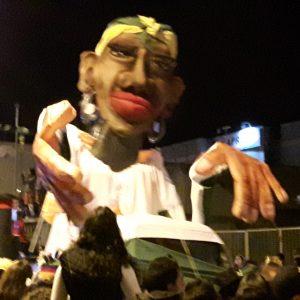
Dia de los Inocentes Parade: Afro-Ecuadorian Float with Music
Día de los Inocentes
Dia de los Santos Inocentes, or Day of the Sainted Innocents, is celebrated in Cuenca by wearing costumes (disfraces) and masks (mascaras) throughout the city. One Cuenca writer compares it to Halloween in North America because it is an excuse to dress up as someone else. We notice that during daylight, around 5 pm, children’s groups were the parade focus and the best adult group displays (comparsas) arrived after 8pm.
Thirty seven years ago the Amistad Club and the Azuay Journalist Union began organizing a parade. They now offer monetary awards to the first, second, and third place winners, with student and other groups competing for best “comparsa” – parade group. The University of Cuenca won again this year. Groups often include live music. It is the final celebration of the holiday season, following El Pase del Niño, La Navidad (Christmas), and Año Viejo. Día de los Inocentes has been celebrated by the Catholic Church since the 15th century and has it’s origins in the biblical reference regarding King Harrod’s edict to kill all boys under 2 years of age, upon learning of the birth of Jesus, “King of the Jews.”
Photographs of moving crowds, especially at night, are challenging! I hope it conveys some of the energy, emotion, and color.
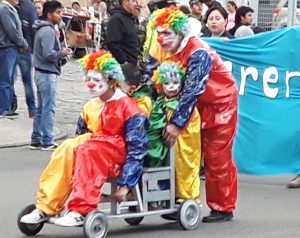
Dia de los Inocentes Parade: So Many Young Children

Dia de Inocentes: Parade on Huayna Capac St — many well-behaved children
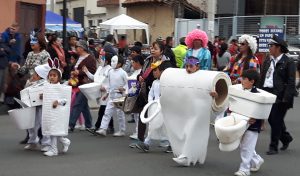
Dia de los Inocentes: Parade on Huayna Capac St — children as bathroom fixtures!

Día de los inocentes — Huayna Capac St — Cow says to butcher “Their blood is on your hands”
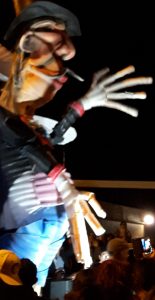
Dia de los Inocentes Parade: Uncle Sam Waves His Hands
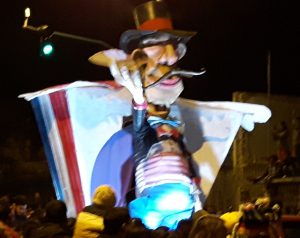
Dia de los Inocentes Parade: Uncle Sam, I Presume
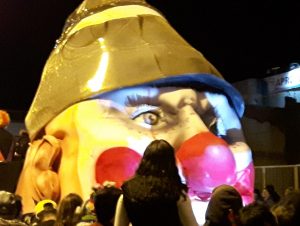
Dia de los Inocentes Parade: This is Tiko Tiko, the Clown, who is the Socialist presidential candidate. (I’m not making this up.)
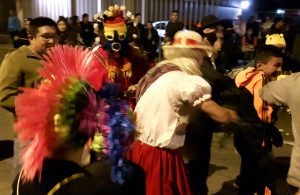
Dia de los Inocentes Parade: Indigenous Spirits and Healers — they “cured” me by putting bunches of lavender in my face, saying “Breathe, breathe!”
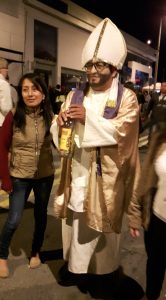
Dia de los Inocentes Parade: The Pope, or Bishop, with bottle of liquor

Dia de los Inocentes: Parade on Huayna Capac — Marching Band with Colorful Hats
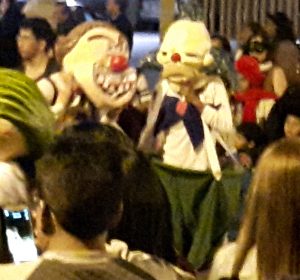
Dia de los Inocentes Parade; Great Masks

Dia de los Inocentes Parade — why giraffes?
Lest anyone think that these celebrations are all that is happening in Cuenca now, there is more.
The night of January 6, the Día de los Inocentes, we found ourselves walking back and forth from the Innocents Parade, on Huayna Capac St, which lasts for hours, and the Cuenca Symphony at El Sagrario (El Nuevo Catedral), 8 pm performance, and catching a seafood dinner at El Capitán in between. Sweet! Walk time between symphony and Huayna Capac is about 10 minutes. We love not needing a car.
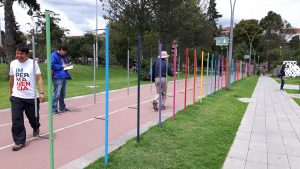
13th Bienal de Cuenca: musical art (Mozart) at Parque de la Madre
During the weekdays we have spent several afternoons visiting the 13th “Bienal de Cuenca” – a 2 1/2 month long, biennial art exposition with 46 artists, located in 20 venues – public and private – all over the central city! The theme of this Bienal is “impermanence.” We have seen presentations that were audio-visual, interactive, 2-D, and 3-D from international and local artists. The dates are from Nov 25 to Feb 5. We love it. A few photos follow.
Given all we have done in the 10+ days we have been back, John says he now experiences Cuenca as a giant adult amusement part! With Cuenca’s seemingly endless art, music, religious, and municipal festivals we often find ourselves choosing which of several events we will attend. For those still in the US, we are sorry but it is hard not to gloat. Cuenca is amazing.
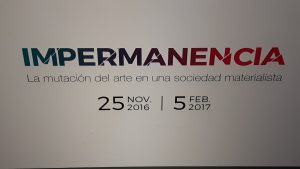
13th Bienal de Cuenca: Theme is “Impermanencia”
Category: Expat Life in Cuenca, Fiestas, religious holidays
